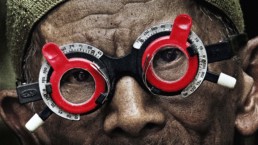Review: ‘The Look of Silence’
Director Joshua Oppenheimer has masterfully crafted another visually stunning and powerful documentary.
In 2014, director Joshua Oppenheimer’s divisive and powerful documentary The Act of Killing, which explored the lives of former Indonesian death-squad leaders, was nominated for an Academy Award. While it ultimately lost out to 20 Feet From Stardom, the film left a lasting impression on many. Now Oppenheimer is back with an equally bold companion piece, coming from the perspective of the victims, in The Look of Silence.
As in The Act of Killing, The Look of Silence’s roots stem from the 1965 Indonesian genocide and execution of perceived communists. The film explores the emotional aftermath that has never been publicly expressed. One family in rural Indonesia who lost their first born son to the hands of these “gangsters” had always tried to bury the past, not wanting to confront the real identify their son’s killer. However, their youngest son Adi Rukun, an optometrist, takes it upon himself to figure out what exactly happened to his big brother many years ago, exposing the perpetrators along the way.
Adi makes house calls as an eye doctor and confronts some of his brother’s murderers. He boldly asks them why they carried out such heinous crimes. It is a tense situation for everyone, including the audience. While Adi confesses to his 100-year-old mother and 103-year-old father that he could forgive the killers if they truly felt remorse, not one of the alleged gangsters demonstrate any sense of responsibility or guilt. “In the afterlife, the victims take revenge,” Adi is told.
The Look of Silence brings the ferocity to the big screen with a delicate lens, and this juxtaposition is the reason why I would claim this is one of the best documentaries of the year.
While there are many moments in the film that leave one speechless, a major revelation shocks Adi to the core. He discovers that his uncle was a guard for the “Death Squad,” indirectly participating in the killing of his brother. With a heavy heart, Adi shares this information with his mother, which is understandably devastating to her. It is a tough scene to get through with dry eyes.
Oppenheimer effectively captures a stunning moment in history in The Look of Silence. Back on board as executive producers are documentary heavyweights, Werner Herzog and Errol Morris. Cinematically, the look of the film is sharper (likely due to a camera upgrade since his previous film), and the story is more condensed. The graphic nature comes mostly from the killers’ own mouths, describing mutilation such as how they cut off women’s breasts, killed men by shoving wood up their anus until it hit their throat, and drinking the blood of their victims to, in their words, “stay sane.” Oppenheimer reverts back to his unique edit of cutting back and forth between television screen and an emotionless protagonist fixated on the images. Instead of Anwar staring at his performance in The Act of Killing, it is now Adi watching an interview with two murderers describing how their victims “screamed, cried, and begged for mercy.”
The Look of Silence is far from a light film, with the weight of all the victims who went without a voice for years, resting on it’s shoulders. Oppenheimer has done a groundbreaking job in exploring an act of terror not widely known, and getting into the mindset of the killers to try to understand “why.” He then comes full circle, focusing on the innocent victims and how they have been affected. The Look of Silence brings the ferocity to the big screen with a delicate lens, and this juxtaposition is the reason why I would claim this is one of the best documentaries of the year. It is not rash to call this film another Oppenheimer masterpiece.
The Look of Silence opens today with a national rollout to follow.
Morgan Rojas
Certified fresh. For disclosure purposes, Morgan currently runs PR at PRETTYBIRD and Ventureland.


